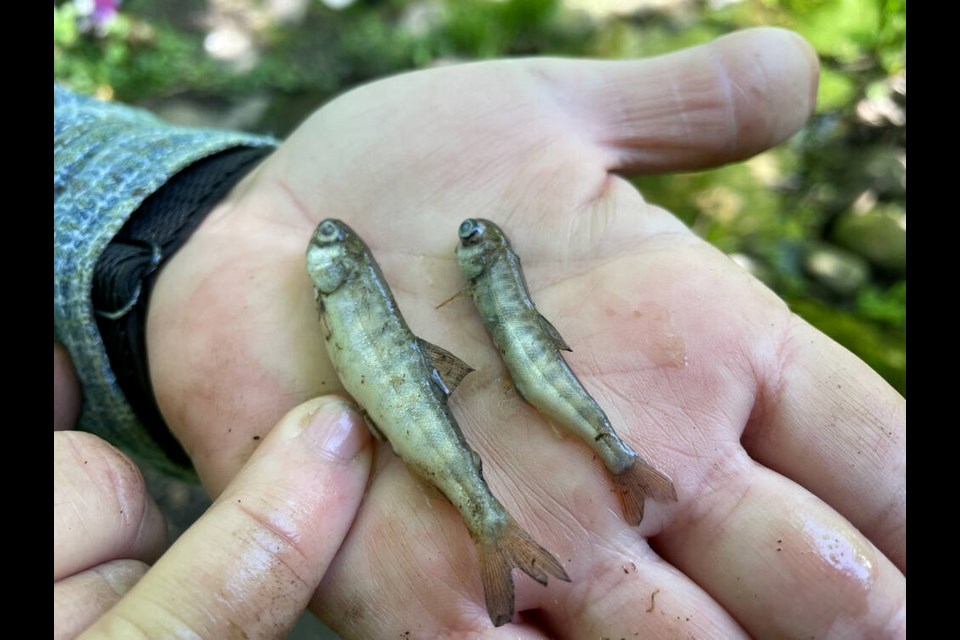Dozens of young salmon have been killed in North Vancouver’s Maplewood Creek, after a suspected spill of chemicals into the storm system.
North Shore Streamkeepers volunteers were making one of their regular visits to the creek Wednesday when one spotted a dead fish. As they made their way down from the stormwater outflow, they found more and more.
“Thirty-seven fish. Everything in that bottom part [of the creek] was dead,” said Zo Ann Morten, streamkeepers volunteer. “There’s nothing left.”
Initially they assumed it had been 6PPD-quinone – a chemical compound used in car tires that accumulates on roadsides and then causes mass fishkills when stormwater moves it into creek systems. Two weeks earlier on the same creek, there had been another fish kill that almost certainly was caused by toxic 6PPD, Morton said.
District of North Vancouver staff came to the site immediately after the Streamkeepers reported it to look for a potential source. There was someone using a power washer with cleaning products in the area connected to the storm system, which is a known threat to aquatic life.
But, because they don’t know for certain when the fish were killed, it’s impossible to conclude the person with the power washer was responsible, said Erika Nassichuk, environmental protection officer.
“Unless we see something really egregious happening, and we see it in the storm system and we see the fish, it’s really hard to pinpoint a cause in these cases when the water is running clear,” she said, adding the investigation remains open.
Nassichuk said her department sees a lot of cases, especially this time of year, of people using cleaning chemicals outside and allowing them to drain carelessly.
“I’d like the message to be clear that people cannot do that in our community. Everything that lands on the roof, sidewalk, and patios ends up in our storm system and in fish habitat directly without being treated,” she said. “We asked people to use only water when they’re power washing. It’s just so detrimental to fish to use any other products.”
Volunteers from the Streamkeepers noticed last year that there was a lot of work happening in the neighbourhood and pre-emptively put up signs at storm drains in the area warning that contaminants in the stormwater go straight to fish-bearing streams
“And so the drain nearby would have been marked if they looked at all. If you have a power washer, you need to know where your products are going,” Morten said.
Under the current Metro Vancouver watering restrictions, power washing is still permitted, but it is a critical time of year for salmonids, Morton said. Salmon fry are just emerging from the gravel, while the smolts are keeping to the lowest parts of the creek preparing to go to the ocean and trout are preparing to spawn.
“So, you can’t really pick a worse time if you tried to do power washing,” Morten said.
With drought conditions expected through 2024, the stakes for fish will be even higher, Morten added.
Valuable habitat at risk
As creeks go, Maplewood is a small tributary of the Seymour River, but, when it doesn’t have chemicals flowing into it, it’s some of the finest fish habitat on the North Shore, said Streamkeepers president Keegan Casidy.
“It’s probably the most abundant small stream. If you went per square foot, it’s got the most fish, guaranteed,” he said.
It’s also one of the most beset by pollutants because it takes so much runoff from Mt. Seymour Parkway. Last fall, 66 per cent of the returning female cohos died before they could spawn, a suspected case of 6PPD contamination.
None of the fishkills in local streams should be viewed as one-offs, Casidy said. It is a systemic issue that happens far more than gets noticed and it is a major threat to biodiversity.
“By the time you’re getting out there, you might find a handful of dead fish but in reality, it’s dozens or hundreds of fish that have died,” he said. “We’re talking a percentage of the total population. And it happens every single rain event.”
Coho salmon are the species most likely to be killed by 6PPD, which is doubly bad luck because they need to spend two full seasons in the creek before they out-migrate to the ocean as smolts.
“That’s why their numbers are getting crushed. By the time they head to the ocean, there’s none of them left,” he said.
There is growing research that shows toxic chemicals like 6PPD can be captured in carefully designed rain gardens near stream intakes or attenuated by capturing stormwater in tanks before releasing it safely.
The federal government is already funding a study into where those hotspots are. Municipalities that have designed and built the infrastructure that is leading to fish mortality need to be showing more leadership in halting toxic runoff at its source, Casidy said, adding that they should also be held to the same legal standards as private companies that dump toxins into the environment.
“Let your local politicians know that this is of importance to you,” he said. “Why should we settle for polluting what is otherwise some of the best, cleanest water in the world?”
Anyone who spots creek pollution in District of North Vancouver creeks should report it immediately to the district at 604-990-2480, after business hours at 604-990-3666, or online any time at dnv.org/government-administration/report-problem



